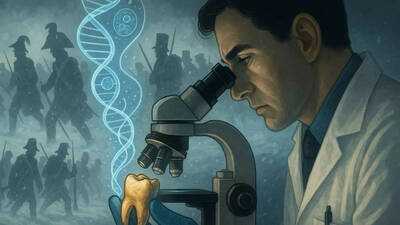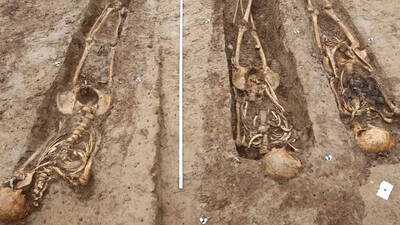Two centuries after Napoleon Bonaparte ’s once-invincible army met its doom in the freezing fields of Eastern Europe, scientists have uncovered new clues about what truly destroyed his forces, and it wasn’t just the brutal Russian winter. Using advanced DNA analysis , researchers have examined the teeth of soldiers buried in a mass grave in Vilnius, Lithuania, revealing that infectious diseases , not frostbite or gunfire, played a major role in one of history’s greatest military catastrophes. The study, published in Current Biology , found traces of two deadly bacteria, paratyphoid fever and relapsing fever, showing that Napoleon’s soldiers were being silently killed from within even as they struggled to survive the cold and hunger.
These findings come from the remains of more than 2,000 soldiers discovered during construction in 2001. Their teeth, remarkably preserved beneath the soil, held microscopic DNA fragments that served as time capsules, preserving the genetic fingerprints of the pathogens that infected them over 200 years ago. Scientists now believe these invisible killers turned the retreat from Russia into a nightmare of fever, exhaustion, and death long before the snow claimed them.
The hidden enemy inside Napoleon’s army
When Napoleon marched into Russia in 1812 with over 600,000 troops, he expected a swift victory. But what awaited was a perfect storm of misfortune, starvation, freezing weather, and disease. The army’s hygiene conditions were appalling. Soldiers wore the same lice-infested clothes for weeks and drank contaminated water. As they weakened, infections spread rapidly through their ranks.
Researchers from the Pasteur Institute in Paris and the Aix-Marseille University found DNA of Salmonella enterica (which causes paratyphoid fever) and Borrelia recurrentis (which causes relapsing fever) in the soldiers’ teeth. These bacteria cause severe fever, vomiting, dehydration, and delirium, all of which would have been fatal in the freezing conditions of the Russian steppe.

“These men were under microbial attack on all fronts,” said Dr Nicolás Rascovan, lead researcher of the study. “They weren’t just fighting the Russians, they were fighting invisible enemies carried in their own blood.”
A mass grave and a scientific breakthrough
The soldiers’ remains were discovered in a mass grave in Vilnius, where Napoleon’s army had stopped to rest during their chaotic retreat. Archaeologists uncovered uniforms, buttons, and weapons alongside the bones, a haunting reminder of the Grande Armée’s collapse. From the grave, 13 teeth were selected for genetic testing.
DNA from these teeth provided an extraordinary glimpse into the soldiers’ final days. Because blood once flowed through the inner chamber of teeth, any bacteria circulating in the bloodstream at the time of death left traces behind. “Teeth act like biological time machines,” explained Dr Rascovan. “They preserve the DNA of the pathogens that infected a person right before they died.”

How disease changed the course of history
For centuries, historians have debated what doomed Napoleon’s Russian campaign. While extreme weather and logistics failures have long been blamed, this new evidence shows that disease was the true silent killer. Typhus, dysentery, and now relapsing fever spread uncontrollably through exhausted troops.
The consequences were catastrophic. Out of 600,000 soldiers, only about 100,000 returned alive. The rest were lost to hunger, cold, or infection. Historians now see the invasion not just as a military failure but as a public health disaster that reshaped Europe’s balance of power.
“War has always been romanticised as glory and conquest,” said bioarchaeologist Michaela Binder of the University of Vienna. “But the bones of these soldiers tell a different story, one of hunger, disease, and suffering. Many were already dying before the enemy even reached them.”
Why this discovery matters today
Understanding what happened to Napoleon’s army isn’t just about solving a 200-year-old mystery. It also helps scientists learn how diseases evolve and spread. The pathogens identified in the study still exist in parts of the world today. By studying their ancient DNA, researchers can track how they changed over time and how modern medicine might stop similar outbreaks in the future.
“Every ancient disease we identify gives us a better sense of how to prevent new ones,” said Dr Leslie Quade, a paleopathologist involved in the research. “History, in this case, becomes a laboratory for understanding pandemics.”
The discovery also serves as a sobering reminder that in war, disease kills far more soldiers than bullets ever do. As Napoleon’s troops learned too late, the most dangerous enemy is often the one you cannot see.
A legacy written in bone and blood
Two hundred years later, the soldiers of Napoleon’s doomed campaign have finally spoken through the DNA sealed in their teeth. What they reveal is not the tale of glorious conquest that history books once told, but a human story of exhaustion, infection, and loss.
Their teeth have preserved more than genetic data; they’ve preserved the truth of a tragedy that changed the course of Europe. The mighty emperor’s fall began not with a cannon blast, but with a fever spreading silently through his army, a reminder that even the most powerful forces in history can be undone by the smallest forms of life.
These findings come from the remains of more than 2,000 soldiers discovered during construction in 2001. Their teeth, remarkably preserved beneath the soil, held microscopic DNA fragments that served as time capsules, preserving the genetic fingerprints of the pathogens that infected them over 200 years ago. Scientists now believe these invisible killers turned the retreat from Russia into a nightmare of fever, exhaustion, and death long before the snow claimed them.
The hidden enemy inside Napoleon’s army
When Napoleon marched into Russia in 1812 with over 600,000 troops, he expected a swift victory. But what awaited was a perfect storm of misfortune, starvation, freezing weather, and disease. The army’s hygiene conditions were appalling. Soldiers wore the same lice-infested clothes for weeks and drank contaminated water. As they weakened, infections spread rapidly through their ranks.
Researchers from the Pasteur Institute in Paris and the Aix-Marseille University found DNA of Salmonella enterica (which causes paratyphoid fever) and Borrelia recurrentis (which causes relapsing fever) in the soldiers’ teeth. These bacteria cause severe fever, vomiting, dehydration, and delirium, all of which would have been fatal in the freezing conditions of the Russian steppe.
“These men were under microbial attack on all fronts,” said Dr Nicolás Rascovan, lead researcher of the study. “They weren’t just fighting the Russians, they were fighting invisible enemies carried in their own blood.”
A mass grave and a scientific breakthrough
The soldiers’ remains were discovered in a mass grave in Vilnius, where Napoleon’s army had stopped to rest during their chaotic retreat. Archaeologists uncovered uniforms, buttons, and weapons alongside the bones, a haunting reminder of the Grande Armée’s collapse. From the grave, 13 teeth were selected for genetic testing.
DNA from these teeth provided an extraordinary glimpse into the soldiers’ final days. Because blood once flowed through the inner chamber of teeth, any bacteria circulating in the bloodstream at the time of death left traces behind. “Teeth act like biological time machines,” explained Dr Rascovan. “They preserve the DNA of the pathogens that infected a person right before they died.”
How disease changed the course of history
For centuries, historians have debated what doomed Napoleon’s Russian campaign. While extreme weather and logistics failures have long been blamed, this new evidence shows that disease was the true silent killer. Typhus, dysentery, and now relapsing fever spread uncontrollably through exhausted troops.
The consequences were catastrophic. Out of 600,000 soldiers, only about 100,000 returned alive. The rest were lost to hunger, cold, or infection. Historians now see the invasion not just as a military failure but as a public health disaster that reshaped Europe’s balance of power.
“War has always been romanticised as glory and conquest,” said bioarchaeologist Michaela Binder of the University of Vienna. “But the bones of these soldiers tell a different story, one of hunger, disease, and suffering. Many were already dying before the enemy even reached them.”
Why this discovery matters today
Understanding what happened to Napoleon’s army isn’t just about solving a 200-year-old mystery. It also helps scientists learn how diseases evolve and spread. The pathogens identified in the study still exist in parts of the world today. By studying their ancient DNA, researchers can track how they changed over time and how modern medicine might stop similar outbreaks in the future.
“Every ancient disease we identify gives us a better sense of how to prevent new ones,” said Dr Leslie Quade, a paleopathologist involved in the research. “History, in this case, becomes a laboratory for understanding pandemics.”
The discovery also serves as a sobering reminder that in war, disease kills far more soldiers than bullets ever do. As Napoleon’s troops learned too late, the most dangerous enemy is often the one you cannot see.
A legacy written in bone and blood
Two hundred years later, the soldiers of Napoleon’s doomed campaign have finally spoken through the DNA sealed in their teeth. What they reveal is not the tale of glorious conquest that history books once told, but a human story of exhaustion, infection, and loss.
Their teeth have preserved more than genetic data; they’ve preserved the truth of a tragedy that changed the course of Europe. The mighty emperor’s fall began not with a cannon blast, but with a fever spreading silently through his army, a reminder that even the most powerful forces in history can be undone by the smallest forms of life.
You may also like

Kathua SSP suspends 8 cops after attack on Kerala preachers

Ankita Lokhande celebrates Diwali with husband Vicky Jain & in-laws at Bilaspur

Moment 'it all went wrong' for Prince Andrew as expert says he's 'not cut out for the job'

Mason Greenwood transfer decision cost Man Utd millions as clause confirmed

Riteish Deshmukh shoots amid the Sahyadri range for 'Raja Shivaji'







